Abstract
1. The in vivo effects of the high affinity sigma ligands 1,3-di(2-tolyl)guanidine (DTG), (+)-N-cyclopropylmethyl-N-methyl-1,4-diphenyl-1- ethyl-but-3-en-1-ylamine hydrochloride (JO-1784), (+)-pentazocine and haloperidol, as well as of those of neuropeptide Y (NPY), on N-methyl-D-aspartate (NMDA)- and quisqualate (Quis)-induced neuronal activations of CA3 pyramidal neurones were assessed, using extracellular unitary recording, in control rats and in rats pretreated with a local injection of pertussis toxin (PTX), to evaluate the possible involvement of Gi/o proteins in mediating the potentiation of the neuronal response to NMDA by the activation of sigma receptors in the dorsal hippocampus. 2. Microiontophoretic applications as well as intravenous injections of (+)-pentazocine potentiated selectively the NMDA response in control rats as well as in PTX-pretreated animals. In contrast, the PTX pretreatment abolished the potentiation of the NMDA response by DTG, JO-1784 and NPY. Moreover, microiontophoretic applications of DTG induced a reduction of NMDA-induced neuronal activation. Neither in control nor in PTX-treated rats, did the sigma ligands and NPY have any effect on Quis-induced neuronal response. 3. In PTX-treated rats, the potentiation of the NMDA response induced by (+)-pentazocine was suppressed by haloperidol, whereas the reduction of the NMDA response by DTG was not affected by haloperidol. 4. This study provides the first in vivo functional evidence that sigma ligands and NPY modulate the NMDA response by acting on distinct receptors, differentiated by their PTX sensitivity.
Full text
PDF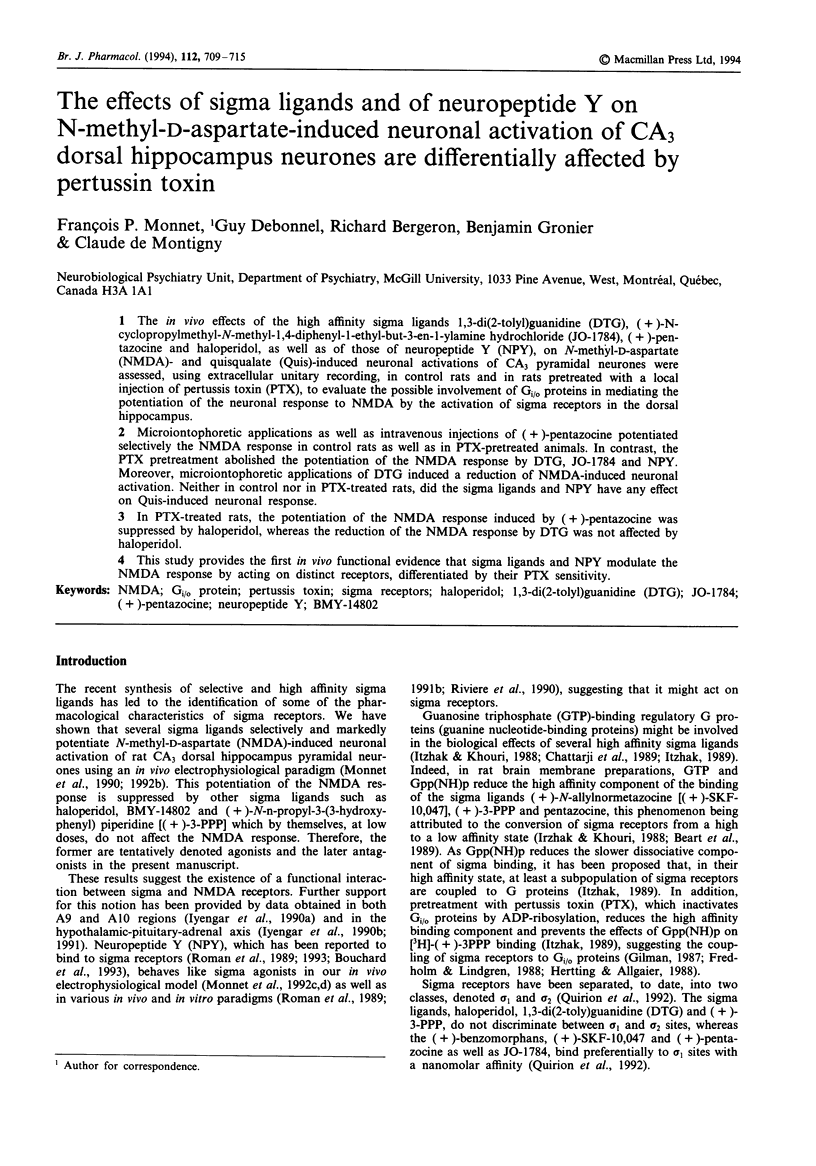
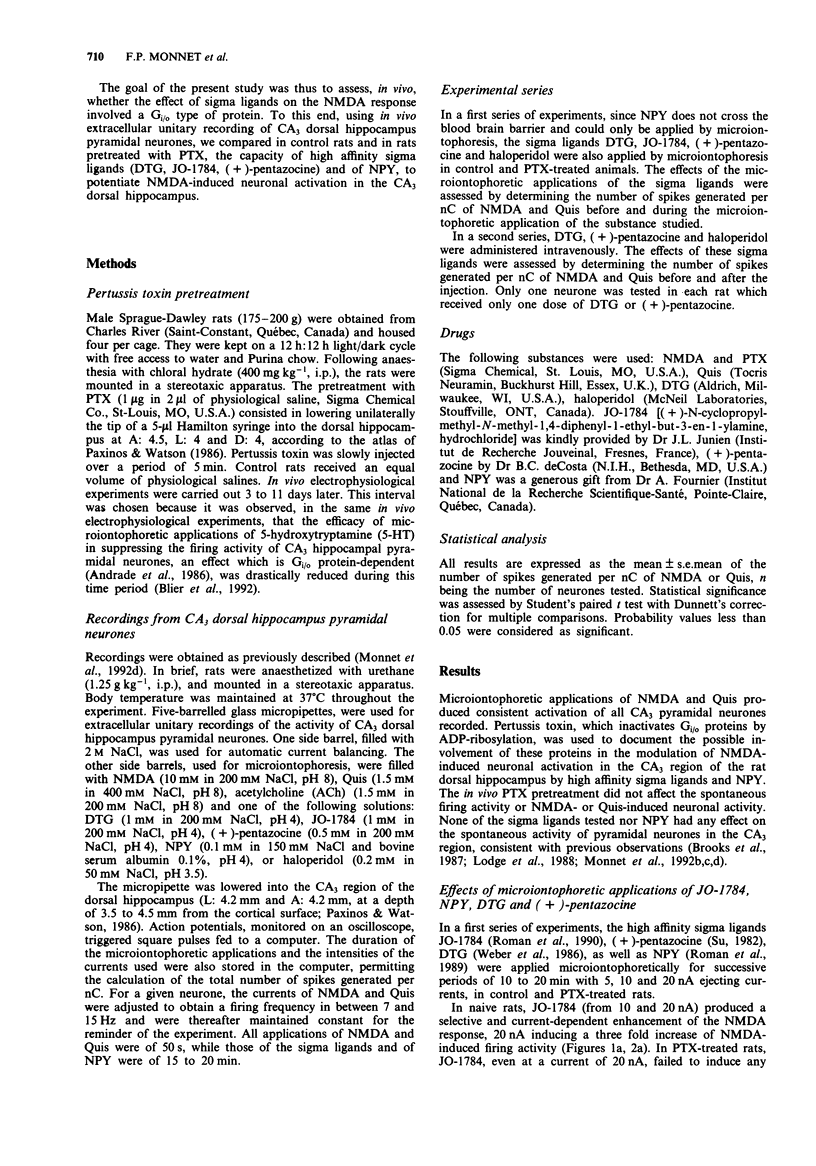
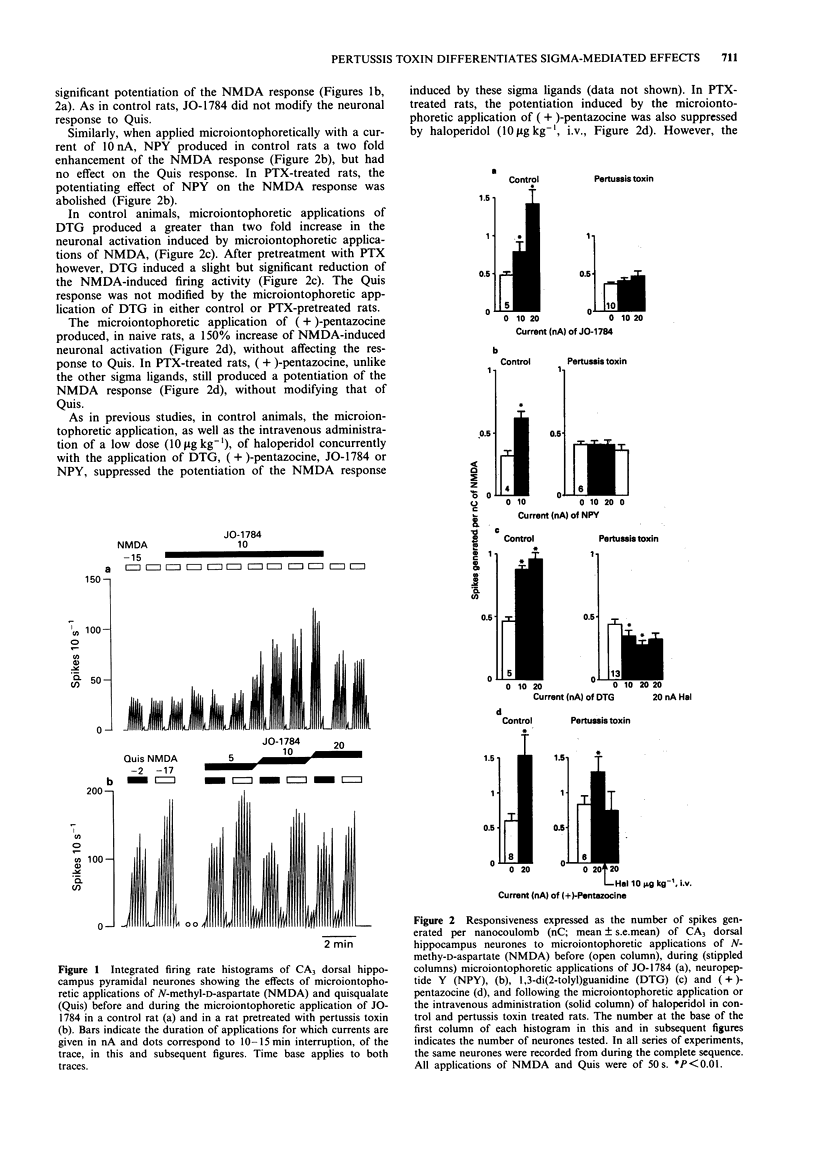
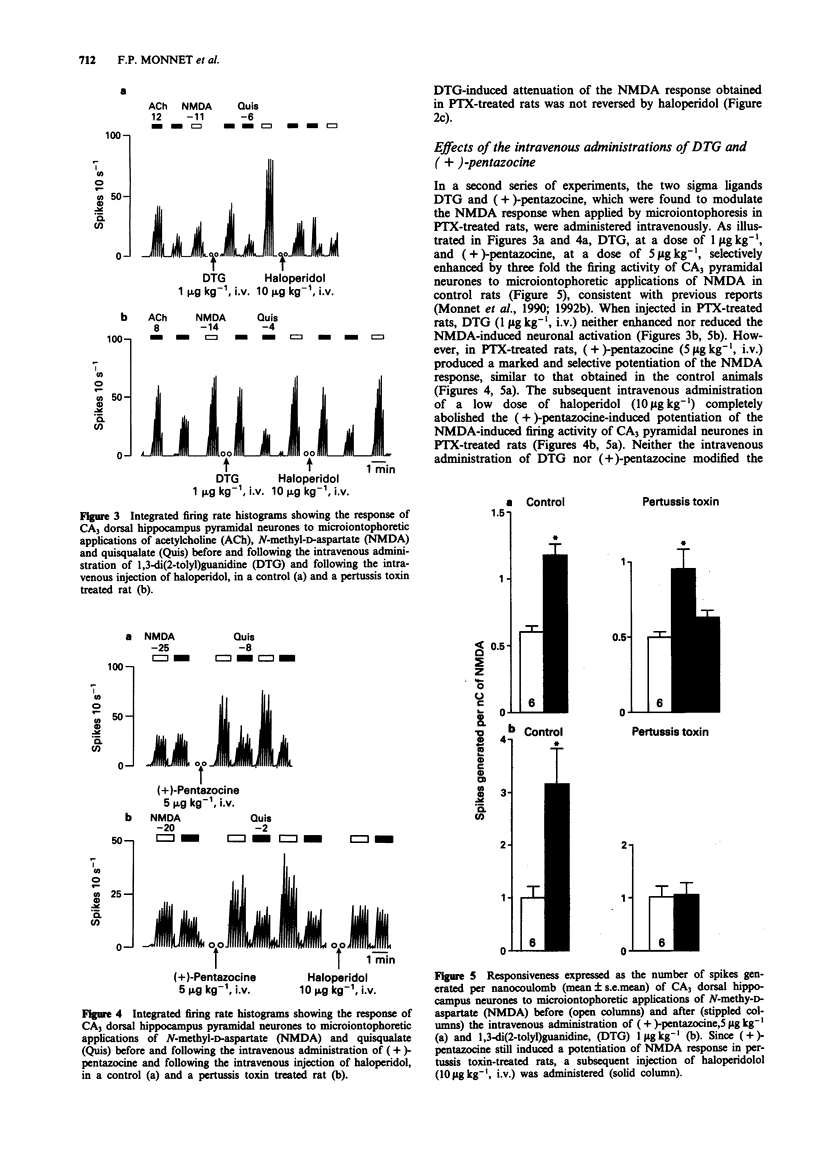
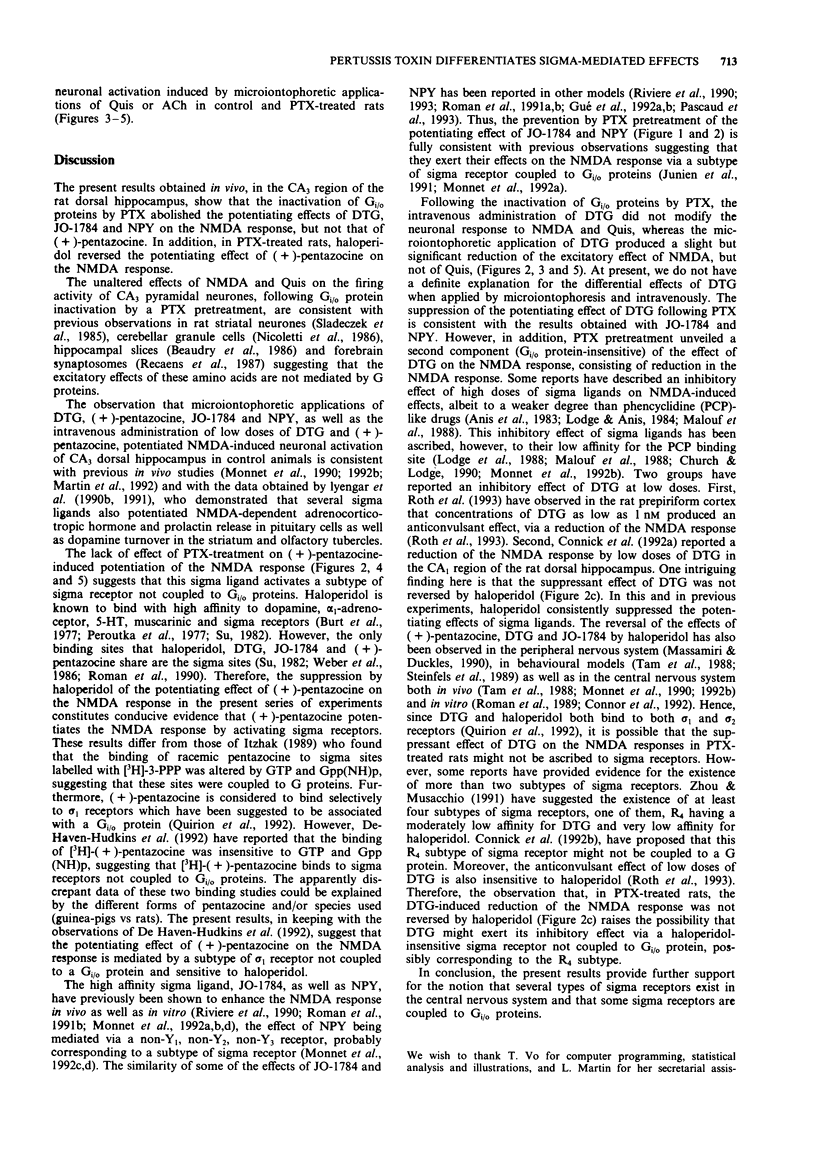
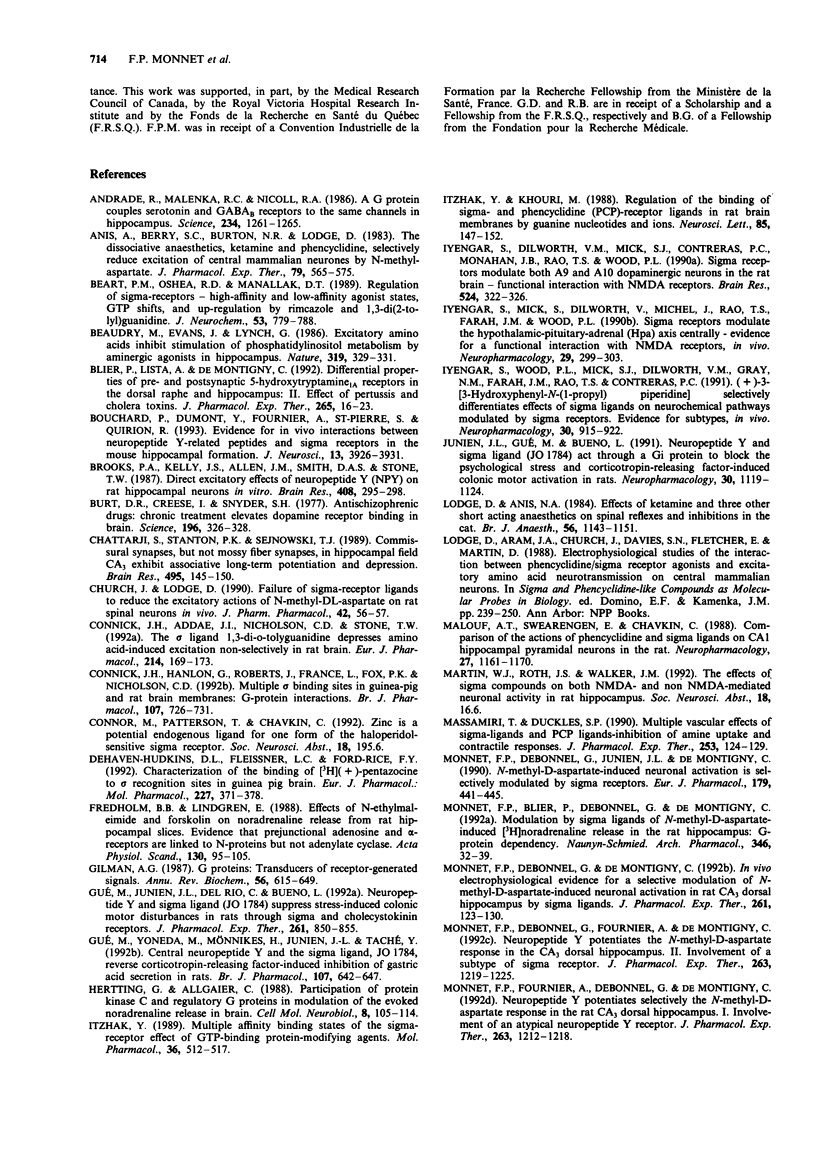
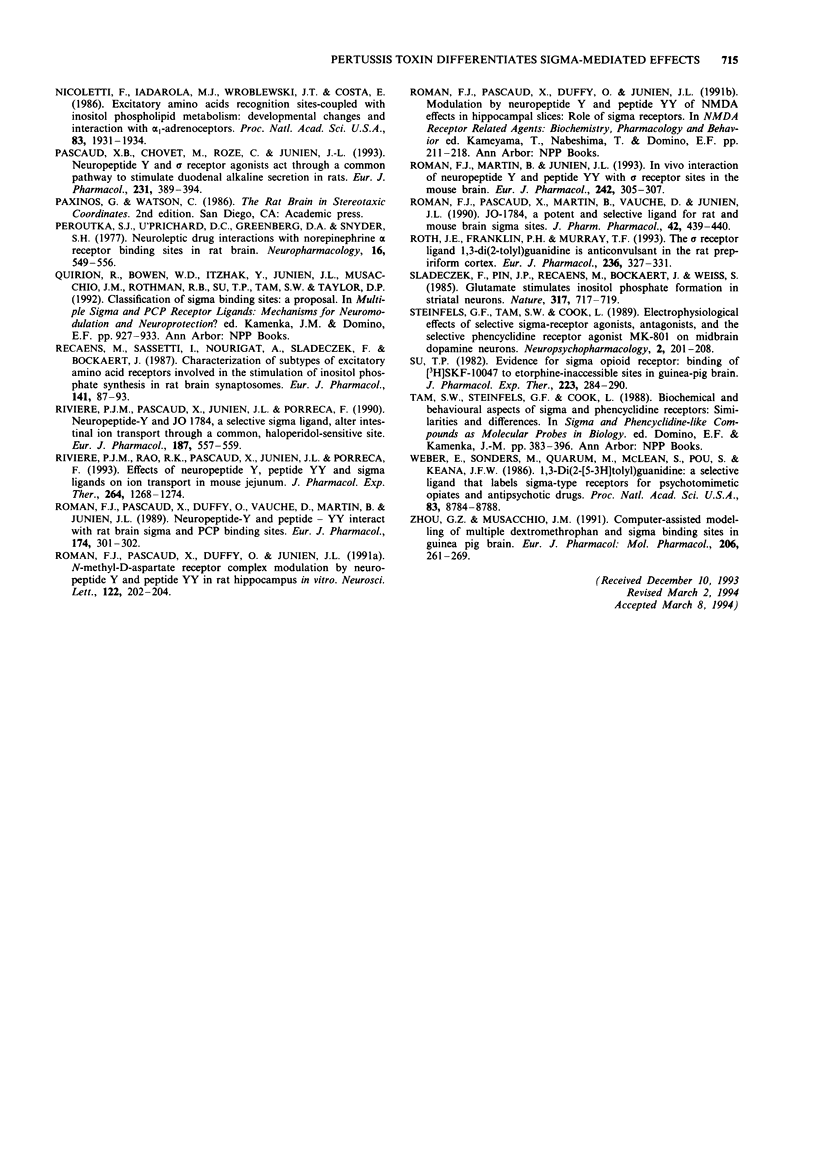
Selected References
These references are in PubMed. This may not be the complete list of references from this article.
- Andrade R., Malenka R. C., Nicoll R. A. A G protein couples serotonin and GABAB receptors to the same channels in hippocampus. Science. 1986 Dec 5;234(4781):1261–1265. doi: 10.1126/science.2430334. [DOI] [PubMed] [Google Scholar]
- Anis N. A., Berry S. C., Burton N. R., Lodge D. The dissociative anaesthetics, ketamine and phencyclidine, selectively reduce excitation of central mammalian neurones by N-methyl-aspartate. Br J Pharmacol. 1983 Jun;79(2):565–575. doi: 10.1111/j.1476-5381.1983.tb11031.x. [DOI] [PMC free article] [PubMed] [Google Scholar]
- Baudry M., Evans J., Lynch G. Excitatory amino acids inhibit stimulation of phosphatidylinositol metabolism by aminergic agonists in hippocampus. Nature. 1986 Jan 23;319(6051):329–331. doi: 10.1038/319329a0. [DOI] [PubMed] [Google Scholar]
- Beart P. M., O'Shea R. D., Manallack D. T. Regulation of sigma-receptors: high- and low-affinity agonist states, GTP shifts, and up-regulation by rimcazole and 1,3-Di(2-tolyl)guanidine. J Neurochem. 1989 Sep;53(3):779–788. doi: 10.1111/j.1471-4159.1989.tb11773.x. [DOI] [PubMed] [Google Scholar]
- Blier P., Lista A., De Montigny C. Differential properties of pre- and postsynaptic 5-hydroxytryptamine1A receptors in the dorsal raphe and hippocampus: II. Effect of pertussis and cholera toxins. J Pharmacol Exp Ther. 1993 Apr;265(1):16–23. [PubMed] [Google Scholar]
- Bouchard P., Dumont Y., Fournier A., St-Pierre S., Quirion R. Evidence for in vivo interactions between neuropeptide Y-related peptides and sigma receptors in the mouse hippocampal formation. J Neurosci. 1993 Sep;13(9):3926–3931. doi: 10.1523/JNEUROSCI.13-09-03926.1993. [DOI] [PMC free article] [PubMed] [Google Scholar]
- Brooks P. A., Kelly J. S., Allen J. M., Smith D. A., Stone T. W. Direct excitatory effects of neuropeptide Y (NPY) on rat hippocampal neurones in vitro. Brain Res. 1987 Apr 7;408(1-2):295–298. doi: 10.1016/0006-8993(87)90391-x. [DOI] [PubMed] [Google Scholar]
- Burt D. R., Creese I., Snyder S. H. Antischizophrenic drugs: chronic treatment elevates dopamine receptor binding in brain. Science. 1977 Apr 15;196(4287):326–328. doi: 10.1126/science.847477. [DOI] [PubMed] [Google Scholar]
- Chattarji S., Stanton P. K., Sejnowski T. J. Commissural synapses, but not mossy fiber synapses, in hippocampal field CA3 exhibit associative long-term potentiation and depression. Brain Res. 1989 Aug 21;495(1):145–150. doi: 10.1016/0006-8993(89)91228-6. [DOI] [PubMed] [Google Scholar]
- Church J., Lodge D. Failure of sigma-receptor ligands to reduce the excitatory actions of N-methyl-DL-aspartate on rat spinal neurons in-vivo. J Pharm Pharmacol. 1990 Jan;42(1):56–57. doi: 10.1111/j.2042-7158.1990.tb05350.x. [DOI] [PubMed] [Google Scholar]
- Connick J. H., Addae J. I., Nicholson C. D., Stone T. W. The sigma ligand 1,3-di-o-tolylguanidine depresses amino acid-induced excitation non-selectively in rat brain. Eur J Pharmacol. 1992 Apr 22;214(2-3):169–173. doi: 10.1016/0014-2999(92)90115-k. [DOI] [PubMed] [Google Scholar]
- Connick J. H., Hanlon G., Roberts J., France L., Fox P. K., Nicholson C. D. Multiple sigma binding sites in guinea-pig and rat brain membranes: G-protein interactions. Br J Pharmacol. 1992 Nov;107(3):726–731. doi: 10.1111/j.1476-5381.1992.tb14514.x. [DOI] [PMC free article] [PubMed] [Google Scholar]
- DeHaven-Hudkins D. L., Fleissner L. C., Ford-Rice F. Y. Characterization of the binding of [3H](+)-pentazocine to sigma recognition sites in guinea pig brain. Eur J Pharmacol. 1992 Dec 1;227(4):371–378. doi: 10.1016/0922-4106(92)90153-m. [DOI] [PubMed] [Google Scholar]
- Fredholm B. B., Lindgren E. Effects of N-ethylmaleimide and forskolin on noradrenaline release from rat hippocampal slices. Evidence that prejunctional adenosine and alpha-receptors are linked to N-proteins but not to adenylate cyclase. Acta Physiol Scand. 1987 May;130(1):95–105. doi: 10.1111/j.1748-1716.1987.tb08116.x. [DOI] [PubMed] [Google Scholar]
- Gilman A. G. G proteins: transducers of receptor-generated signals. Annu Rev Biochem. 1987;56:615–649. doi: 10.1146/annurev.bi.56.070187.003151. [DOI] [PubMed] [Google Scholar]
- Gue M., Junien J. L., Del Rio C., Bueno L. Neuropeptide Y and sigma ligand (JO 1784) suppress stress-induced colonic motor disturbances in rats through sigma and cholecystokinin receptors. J Pharmacol Exp Ther. 1992 Jun;261(3):850–855. [PubMed] [Google Scholar]
- Gué M., Yoneda M., Mönnikes H., Junien J. L., Taché Y. Central neuropeptide Y and the sigma ligand, JO 1784, reverse corticotropin-releasing factor-induced inhibition of gastric acid secretion in rats. Br J Pharmacol. 1992 Nov;107(3):642–647. doi: 10.1111/j.1476-5381.1992.tb14500.x. [DOI] [PMC free article] [PubMed] [Google Scholar]
- Hertting G., Allgaier C. Participation of protein kinase C and regulatory G proteins in modulation of the evoked noradrenaline release in brain. Cell Mol Neurobiol. 1988 Mar;8(1):105–114. doi: 10.1007/BF00712916. [DOI] [PubMed] [Google Scholar]
- Itzhak Y., Khouri M. Regulation of the binding of sigma- and phencyclidine (PCP)-receptor ligands in rat brain membranes by guanine nucleotides and ions. Neurosci Lett. 1988 Feb 15;85(1):147–152. doi: 10.1016/0304-3940(88)90445-4. [DOI] [PubMed] [Google Scholar]
- Itzhak Y. Multiple affinity binding states of the sigma receptor: effect of GTP-binding protein-modifying agents. Mol Pharmacol. 1989 Oct;36(4):512–517. [PubMed] [Google Scholar]
- Iyengar S., Dilworth V. M., Mick S. J., Contreras P. C., Monahan J. B., Rao T. S., Wood P. L. Sigma receptors modulate both A9 and A10 dopaminergic neurons in the rat brain: functional interaction with NMDA receptors. Brain Res. 1990 Aug 6;524(2):322–326. doi: 10.1016/0006-8993(90)90709-k. [DOI] [PubMed] [Google Scholar]
- Iyengar S., Mick S., Dilworth V., Michel J., Rao T. S., Farah J. M., Wood P. L. Sigma receptors modulate the hypothalamic-pituitary-adrenal (HPA) axis centrally: evidence for a functional interaction with NMDA receptors, in vivo. Neuropharmacology. 1990 Mar;29(3):299–303. doi: 10.1016/0028-3908(90)90017-l. [DOI] [PubMed] [Google Scholar]
- Iyengar S., Wood P. L., Mick S. J., Dilworth V. M., Gray N. M., Farah J. M., Rao T. S., Contreras P. C. (+) 3-[3-hydroxyphenyl-N-(1-propyl) piperidine] selectively differentiates effects of sigma ligands on neurochemical pathways modulated by sigma receptors: evidence for subtypes, in vivo. Neuropharmacology. 1991 Aug;30(8):915–922. doi: 10.1016/0028-3908(91)90127-w. [DOI] [PubMed] [Google Scholar]
- Junien J. L., Gue M., Bueno L. Neuropeptide Y and sigma ligand (JO 1784) act through a Gi protein to block the psychological stress and corticotropin-releasing factor-induced colonic motor activation in rats. Neuropharmacology. 1991 Oct;30(10):1119–1124. doi: 10.1016/0028-3908(91)90142-x. [DOI] [PubMed] [Google Scholar]
- Lodge D., Anis N. A. Effects of ketamine and three other anaesthetics on spinal reflexes and inhibitions in the cat. Br J Anaesth. 1984 Oct;56(10):1143–1151. doi: 10.1093/bja/56.10.1143. [DOI] [PubMed] [Google Scholar]
- Malouf A. T., Swearengen E., Chavkin C. Comparison of the actions of phencyclidine and sigma ligands on CA1 hippocampal pyramidal neurons in the rat. Neuropharmacology. 1988 Nov;27(11):1161–1170. doi: 10.1016/0028-3908(88)90012-3. [DOI] [PubMed] [Google Scholar]
- Massamiri T., Duckles S. P. Multiple vascular effects of sigma and PCP ligands: inhibition of amine uptake and contractile responses. J Pharmacol Exp Ther. 1990 Apr;253(1):124–129. [PubMed] [Google Scholar]
- Monnet F. P., Blier P., Debonnel G., de Montigny C. Modulation by sigma ligands of N-methyl-D-aspartate-induced [3H]noradrenaline release in the rat hippocampus: G-protein dependency. Naunyn Schmiedebergs Arch Pharmacol. 1992 Jul;346(1):32–39. doi: 10.1007/BF00167567. [DOI] [PubMed] [Google Scholar]
- Monnet F. P., Debonnel G., Fournier A., de Montigny C. Neuropeptide Y potentiates the N-methyl-D-aspartate response in the CA3 dorsal hippocampus. II. Involvement of a subtype of sigma receptor. J Pharmacol Exp Ther. 1992 Dec;263(3):1219–1225. [PubMed] [Google Scholar]
- Monnet F. P., Debonnel G., Junien J. L., De Montigny C. N-methyl-D-aspartate-induced neuronal activation is selectively modulated by sigma receptors. Eur J Pharmacol. 1990 Apr 25;179(3):441–445. doi: 10.1016/0014-2999(90)90186-a. [DOI] [PubMed] [Google Scholar]
- Monnet F. P., Debonnel G., de Montigny C. In vivo electrophysiological evidence for a selective modulation of N-methyl-D-aspartate-induced neuronal activation in rat CA3 dorsal hippocampus by sigma ligands. J Pharmacol Exp Ther. 1992 Apr;261(1):123–130. [PubMed] [Google Scholar]
- Nicoletti F., Iadarola M. J., Wroblewski J. T., Costa E. Excitatory amino acid recognition sites coupled with inositol phospholipid metabolism: developmental changes and interaction with alpha 1-adrenoceptors. Proc Natl Acad Sci U S A. 1986 Mar;83(6):1931–1935. doi: 10.1073/pnas.83.6.1931. [DOI] [PMC free article] [PubMed] [Google Scholar]
- Pascaud X. B., Chovet M., Roze C., Junien J. L. Neuropeptide Y and sigma receptor agonists act through a common pathway to stimulate duodenal alkaline secretion in rats. Eur J Pharmacol. 1993 Feb 16;231(3):389–394. doi: 10.1016/0014-2999(93)90115-x. [DOI] [PubMed] [Google Scholar]
- Peroutka S. J., U'Prichard D. C., Greenberg D. A., Snyder S. H. Neuroleptic drug interactions with norepinephrine alpha receptor binding sites in rat brain. Neuropharmacology. 1977 Sep;16(9):549–556. doi: 10.1016/0028-3908(77)90023-5. [DOI] [PubMed] [Google Scholar]
- Riviere P. J., Rao R. K., Pascaud X., Junien J. L., Porreca F. Effects of neuropeptide Y, peptide YY and sigma ligands on ion transport in mouse jejunum. J Pharmacol Exp Ther. 1993 Mar;264(3):1268–1274. [PubMed] [Google Scholar]
- Rivière P. J., Pascaud X., Junien J. L., Porreca F. Neuropeptide Y and JO 1784, a selective sigma ligand, alter intestinal ion transport through a common, haloperidol-sensitive site. Eur J Pharmacol. 1990 Oct 23;187(3):557–559. doi: 10.1016/0014-2999(90)90388-m. [DOI] [PubMed] [Google Scholar]
- Roman F. J., Martin B., Junien J. L. In vivo interaction of neuropeptide Y and peptide YY with sigma receptor sites in the mouse brain. Eur J Pharmacol. 1993 Oct 5;242(3):305–307. doi: 10.1016/0014-2999(93)90255-g. [DOI] [PubMed] [Google Scholar]
- Roman F. J., Pascaud X., Duffy O., Junien J. L. N-methyl-D-aspartate receptor complex modulation by neuropeptide Y and peptide YY in rat hippocampus in vitro. Neurosci Lett. 1991 Jan 28;122(2):202–204. doi: 10.1016/0304-3940(91)90858-q. [DOI] [PubMed] [Google Scholar]
- Roman F. J., Pascaud X., Duffy O., Vauche D., Martin B., Junien J. L. Neuropeptide Y and peptide YY interact with rat brain sigma and PCP binding sites. Eur J Pharmacol. 1989 Dec 19;174(2-3):301–302. doi: 10.1016/0014-2999(89)90326-9. [DOI] [PubMed] [Google Scholar]
- Roman F. J., Pascaud X., Martin B., Vauché D., Junien J. L. JO 1784, a potent and selective ligand for rat and mouse brain sigma-sites. J Pharm Pharmacol. 1990 Jun;42(6):439–440. doi: 10.1111/j.2042-7158.1990.tb06588.x. [DOI] [PubMed] [Google Scholar]
- Roth J. E., Franklin P. H., Murray T. F. The sigma receptor ligand 1,3-di(2-tolyl)guanidine is anticonvulsant in the rat prepiriform cortex. Eur J Pharmacol. 1993 May 19;236(2):327–331. doi: 10.1016/0014-2999(93)90607-j. [DOI] [PubMed] [Google Scholar]
- Récasens M., Sassetti I., Nourigat A., Sladeczek F., Bockaert J. Characterization of subtypes of excitatory amino acid receptors involved in the stimulation of inositol phosphate synthesis in rat brain synaptoneurosomes. Eur J Pharmacol. 1987 Sep 2;141(1):87–93. doi: 10.1016/0014-2999(87)90413-4. [DOI] [PubMed] [Google Scholar]
- Sladeczek F., Pin J. P., Récasens M., Bockaert J., Weiss S. Glutamate stimulates inositol phosphate formation in striatal neurones. Nature. 1985 Oct 24;317(6039):717–719. doi: 10.1038/317717a0. [DOI] [PubMed] [Google Scholar]
- Steinfels G. F., Tam S. W., Cook L. Electrophysiological effects of selective sigma-receptor agonists, antagonists, and the selective phencyclidine receptor agonist MK-801 on midbrain dopamine neurons. Neuropsychopharmacology. 1989 Sep;2(3):201–208. doi: 10.1016/0893-133x(89)90023-7. [DOI] [PubMed] [Google Scholar]
- Su T. P. Evidence for sigma opioid receptor: binding of [3H]SKF-10047 to etorphine-inaccessible sites in guinea-pig brain. J Pharmacol Exp Ther. 1982 Nov;223(2):284–290. [PubMed] [Google Scholar]
- Weber E., Sonders M., Quarum M., McLean S., Pou S., Keana J. F. 1,3-Di(2-[5-3H]tolyl)guanidine: a selective ligand that labels sigma-type receptors for psychotomimetic opiates and antipsychotic drugs. Proc Natl Acad Sci U S A. 1986 Nov;83(22):8784–8788. doi: 10.1073/pnas.83.22.8784. [DOI] [PMC free article] [PubMed] [Google Scholar]
- Zhou G. Z., Musacchio J. M. Computer-assisted modeling of multiple dextromethorphan and sigma binding sites in guinea pig brain. Eur J Pharmacol. 1991 Apr 25;206(4):261–269. doi: 10.1016/0922-4106(91)90108-t. [DOI] [PubMed] [Google Scholar]


